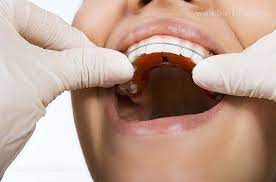Understanding the various types of dental appliances and how they function can help you make informed decisions about your oral health. Dental Appliances are custom-made tools used in prevention, treatment, and correction of numerous dental issues. From braces and retainers to guards and aligners, this complete guide will walk you through the different types, their purposes, and how they contribute to a healthier mouth. Whether you need to straighten teeth, protect your smile, or manage a dental condition, there’s a dental appliance designed for it.
Orthodontic Appliances:
Orthodontic appliances are designed to correct alignment issues, support jaw development, and maintain proper spacing of teeth.
- Braces use brackets and wires to gradually move teeth into proper alignment
- Clear aligners (like Invisalign) are removable trays that correct alignment discreetly
- Retainers keep teeth in place after orthodontic treatment is complete
- Palatal expanders widen the upper jaw to make room for incoming teeth
- Headgear appliances apply force to the jaw and upper teeth to guide growth
- Space maintainers prevent shifting of teeth in children who have lost baby teeth early
These appliances are often used in adolescence but can be effective for adults too.
Protective Appliances:
Protective dental appliances are used to shield teeth from damage during physical activity or while sleeping.
- Mouthguards are worn during sports to prevent impact injuries to the teeth and jaw
- Night guards help prevent teeth grinding (bruxism) and reduce strain on the jaw
- Bite splints manage TMJ disorders by keeping the jaw in a stable position
- Snoring guards reposition the jaw or tongue to open the airway during sleep
- Custom-fit guards offer better protection and comfort than store-bought versions
Using protective appliances consistently can help prevent costly dental emergencies.
Restorative Appliances:
Restorative appliances replace or support damaged or missing teeth to restore function and aesthetics.
- Dentures are removable appliances used to replace multiple missing teeth
- Partial dentures fill in gaps while preserving existing natural teeth
- Dental bridges are fixed prosthetics that bridge gaps using crowns on adjacent teeth
- Implant-supported appliances offer a more permanent and stable tooth replacement
- Temporary crowns or bridges are used while permanent versions are being fabricated
- Overdentures fit over remaining roots or implants for added stability
These appliances are often necessary after tooth loss due to decay, injury, or age.
Functional and Therapeutic Appliances:
These appliances are used to treat underlying oral health conditions that affect functionality and comfort.
- Mandibular advancement devices (MADs) treat obstructive sleep apnea by adjusting jaw position
- Tongue-retaining devices help keep the airway open during sleep
- Myofunctional appliances correct improper oral habits in children, such as tongue thrust
- Habit-breaking appliances discourage thumb-sucking or nail-biting
- TMJ appliances reduce jaw pain and muscle tension associated with temporomandibular disorders
- Expansion plates help improve breathing and jaw growth in children
Functional appliances can significantly improve long-term oral and systemic health when used correctly.
Pediatric Dental Appliances:
Children often require specialized dental appliances to guide their developing mouths and prevent future issues.
- Space maintainers keep the area open for permanent teeth to erupt properly
- Thumb-sucking deterrents are fitted to the upper jaw to break oral habits
- Early braces or aligners correct bite issues before they worsen with age
- Growth modification appliances help shape the jaw during developmental years
- Pediatric night guards protect young teeth from grinding during sleep
- Fluoride trays or retainers may be used to apply protective fluoride directly to teeth
Early intervention with pediatric appliances often prevents more invasive treatments later in life.
Maintenance and Care of Dental Appliances:
Proper care ensures that Dental Appliances Treatment last longer and function effectively over time.
- Clean appliances daily with a soft brush and non-abrasive cleaner to remove bacteria
- Avoid hot water, which can warp plastic or acrylic materials
- Store in a dry, ventilated container when not in use to prevent damage or contamination
- Avoid chewing or biting hard objects while wearing the appliance
- Attend regular check-ups so your dentist can assess fit and condition
- Report discomfort or breakage immediately to prevent complications or delays in treatment
A well-maintained appliance is more effective, comfortable, and less likely to require frequent replacements.





Comments